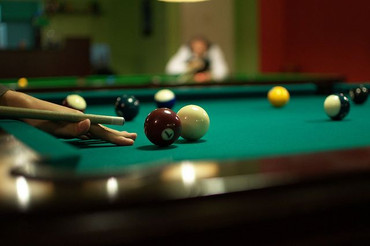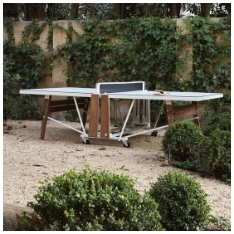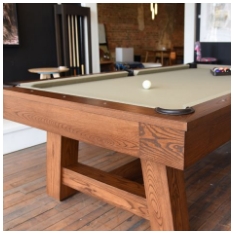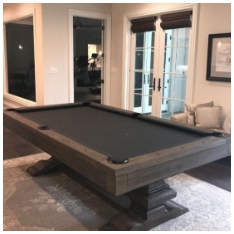When investing in a pool table, one of the most important decisions is choosing the slate thickness. Slate is the material used for the playing surface, and its quality directly impacts how smooth and consistent the game feels. Two common options are ¾ inch slate and 1 inch slate, and while the difference might sound small, it plays a significant role in durability, gameplay, installation, and cost.
This article breaks down the key differences between pool table slate thickness: ¾ inch vs 1 inch, helping you decide which option fits your needs best.
Understanding Slate in Pool Tables
Slate is a fine-grained rock that is cut, leveled, and polished to create a flat playing surface. Its stability makes it the gold standard for professional and home pool tables. Unlike wood or synthetic surfaces, slate resists warping and maintains its shape over time.
The thickness of slate determines how stable the table feels, how long it lasts, and how accurately balls roll across the surface. That’s why understanding ¾ inch vs 1 inch pool table slate is crucial before making a purchase.
Pool Table Slate Thickness Options
¾ Inch Slate
- Lighter weight: Easier to move and install.
- Lower cost: Typically found in entry-level or budget-friendly tables.
- Performance: Provides a decent playing surface but may not meet professional standards.
- Durability: More prone to cracking if moved improperly.
1 Inch Slate
- Heavier weight: Adds stability to the table and reduces vibration.
- Professional standard: Most tournament and commercial tables use 1 inch slate.
- Longevity: Resistant to warping and damage over time.
- Cost: Higher price due to material thickness and quality.
Why Slate Thickness Matters
The difference between ¾ inch vs 1 inch pool table slate is more than just numbers. It affects nearly every aspect of the game.
1. Stability and Weight
- ¾ Inch Slate: Because it is thinner, the table is lighter. This can be beneficial for easier delivery and setup, but it also means the table is less stable. Any movement of the table might affect the roll of the balls.
- 1 Inch Slate: The added weight anchors the table, providing a stable, vibration-free experience. This ensures balls roll smoothly and consistently, even under heavy play.
2. Durability
- ¾ Inch Slate: More fragile, especially during transport or installation. A small crack can affect gameplay.
- 1 Inch Slate: Built to last for decades with proper care, making it ideal for long-term investment.
3. Gameplay Experience
- ¾ Inch Slate: Suitable for casual play. However, slight inconsistencies may develop over time.
- 1 Inch Slate: Delivers a true, consistent roll and meets professional gameplay standards.
4. Cost Considerations
- ¾ Inch Slate: Less expensive upfront, making it attractive for budget-conscious buyers.
- 1 Inch Slate: Higher initial cost, but greater longevity makes it more cost-effective in the long run.
Installation and Moving
The installation process is another factor when comparing pool table slate thickness: ¾ inch vs 1 inch.
- ¾ Inch Slate Tables: Lighter and easier to move. Often come in one-piece slate designs, which are manageable in smaller spaces but harder to level perfectly.
- 1 Inch Slate Tables: Heavier and typically divided into three pieces for easier handling. While installation requires more effort, the result is a precisely leveled surface.

Professional vs Home Use
For Home Players
If you want a pool table primarily for casual family fun, a ¾ inch slate table can be sufficient. It provides good playability without the higher cost of thicker slate.
For Serious Players
If you are serious about billiards, plan to practice regularly, or want a table that matches tournament standards, 1 inch slate is the better choice. It ensures professional accuracy and durability.
Comparing Longevity
A pool table is an investment, and its lifespan is tied to slate thickness.
- ¾ Inch Slate: May last 10–15 years if well-maintained, though risks of cracking or warping are higher.
- 1 Inch Slate: Can last 20–30 years or more, maintaining a professional playing surface throughout.
Resale Value
When considering long-term value, 1 inch slate pool tables hold their resale price better. Buyers recognize them as professional-grade, while tables with ¾ inch slate are often seen as entry-level and depreciate faster.
Which Slate Thickness Should You Choose?
Your choice depends on your goals:
- Choose ¾ Inch Slate If:
- You are on a budget.
- You need a lighter table for easier setup or smaller rooms.
- You plan to use it casually without concern for professional standards.
- Choose 1 Inch Slate If:
- You want professional-grade play.
- You want a long-term investment.
- You prefer higher durability and stability.
- You want better resale value in the future.
Maintenance Tips for Both Slate Types
Regardless of ¾ inch vs 1 inch slate, proper maintenance extends the life of your pool table.
- Keep the surface covered when not in use to protect against dust and spills.
- Maintain room conditions with moderate temperature and humidity to prevent felt damage.
- Avoid moving the table without professional help to prevent slate cracks.
- Re-felt periodically to maintain smooth gameplay.
Final Thoughts
The debate around pool table slate thickness: ¾ inch vs 1 inch comes down to priorities. If cost and mobility are key, ¾ inch slate is a practical choice. If long-term quality, professional gameplay, and stability matter most, 1 inch slate is the clear winner.
Whether for home entertainment or professional-level practice, understanding slate thickness ensures you make an informed investment in your pool table.





